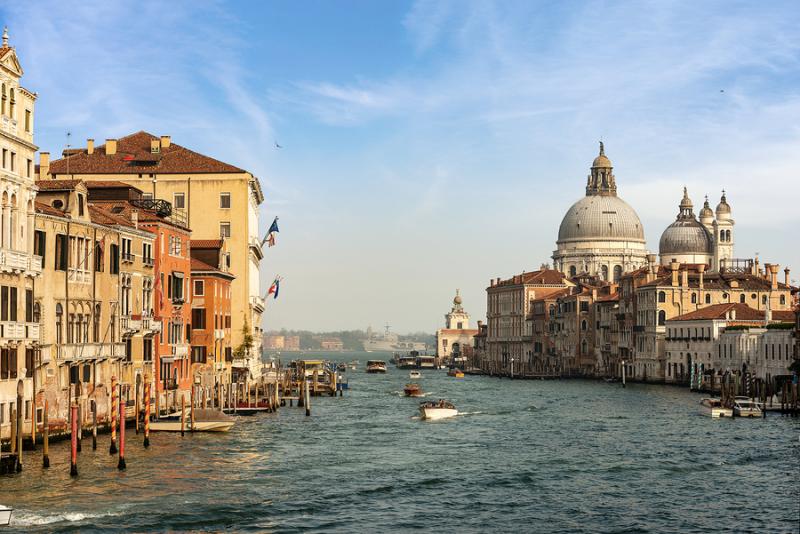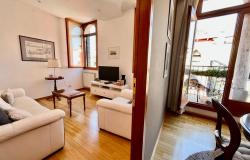Visitors to Venice cannot help but wander around admiring the facades of endless palazzi, perhaps wondering what they are like on the inside. The Biennale offers the opportunity to go inside a few of these magnificent buildings when they open to the public for several months to display art exhibitions, but there are many more buildings which the tourist can never explore. It’s hard to imagine that people actually live in these magical palaces, and even harder to have a sense of what everyday life is like when all your front windows look out onto the Grand Canal, and your kitchen has a vista of the rooftops, pepper pot chimneys and campanile of the most beautiful city in the world.

Times have changed, but people adapt. Marchesa Barbara Berlingieri came to live in the Palazzo Treves 55 years ago on her marriage, and has wonderful stories to tell about living there, in what must be the palazzo with the best view in all Venice. If I describe the Palazzo Treves as opposite Longhena’s magnificent Santa Maria della Salute church at the mouth of the Grand Canal, readers will instantly know where it is. The balconies look towards the Dogana (customs house) and across to the island of San Giorgio Maggiore on one side, and beyond the Salute to the Guggenheim Museum on the other.

The Palazzo Barozzi Emo Treves de Bonfil, to give it its full name, was built in the 12th century and reconstructed in the 18th. Like most Italian grand houses the long name reflects the owners of the property over the years, ending with the most recent. In 1827 it was bought by the Treves, a banking family, who extended it so that the frontage on the Grand Canal now appears asymmetrical. On the right is the original gothic façade, and on the left, the neo-classical extension. We can once again see and admire this frontage after four years behind scaffolding whilst restoration was taking place. Now the same treatment has happened to the building next door, the former Hotel Europa, which was temporarily closed, but has now reopened as the St Regis Hotel.
The original façade, unusually, was on the side canal to the right as you face the building. This small canal is very busy with gondolas creating mini traffic jams from the pick up point at San Moisé then moving on to the Grand Canal. As I sat watching the scene from the balcony as the Marchesa answered the phone, a gondola carrying three young men emerged round the corner. Seconds later a speed boat coming from behind swerved round them, drenching the passengers and the gondolier in a giant curved wave of water. The gondolier was furious and shouted, making a lot of obscene gestures. I began to laugh as they wrung out their shirts – no harm done. When they noticed me on the balcony above they waved and laughed too, canal rage forgotten on a lovely sunny day.

I’d had a little difficulty finding the entrance to the Palazzo. Of course there’s the main doorway on the Grand Canal, but as I wasn’t arriving by water taxi or gondola, I had to weave my way along alleyways from the vaporetto stop to find the rear entrance. The housekeeper came to the rescue and met me in a small courtyard, taking me in a lift to the office where Barbara was waiting with glasses of iced water.
We chatted about life in a Venetian palazzo. Barbara had married young, half a century ago, and didn’t know Venice at all when she came to live there. Luckily she had an aunt who took her under her wing and was determined that she would grow to love the city.
“The Baronessa Treves made a real effort to make me fall in love with Venice,” Barbara remembered.
They explored the whole city by gondola, and often took a route which passed La Fenice Opera House, where they went to operas together many times. It wasn’t until months later that Barbara began to realise that La Fenice was in fact very close to Palazzo Treves and they could have got there much faster on foot.
Of course travelling around by gondola is so much easier when you have the family gondola at your disposal. In the Grand Canal entrance hall (still used) of the palazzo stands their own gondola, still with its original cover used originally both to protect and conceal its passengers.

This hall acts as a sort of garage, with a jetty from the front door. To each side there are doors which originally led to the accommodation for their gondolier and his family. He had to be ready at a moment’s notice to take his employers anywhere they wished to go, or spend the rest of his time maintaining the boat.
The Marchesa herself became a skilled oarswoman and has participated in the Vogalonga, the 30k race around Venice and its islands. There are charming photos in the office of her competing with friends.

It was a great relief to the family when the restoration was finally complete and the scaffolding taken down. But these days, with such grand and ancient buildings, there is the constant problem of how to maintain them. The solution for this family was to convert some of the space into luxury rentals, the Canova apartments. They are beautifully furnished with antiques, and lead to a rooftop terrace, the former altana, where there are views over the Venetian skyline. (Centuries ago Venetian women used these wooden structures to spread out their hair to dry and bleach in the sun.) But the best rooms of course are the family’s, and open on to the Grand Canal.

The Baroness certainly succeeded in making an impression on her young niece, and instilling a love of Venice which over the years has shown itself in her work on various committees which all have the purpose of preserving the city and its unique architecture. I had noticed in the office overlooking the Grand Canal that there were very many photographs, including some faces I recognised. When I asked about the signed photo of Prince and Princess Michael of Kent, she explained that they had become dear friends because they are active members of the same Save Venice Committee. She also works with the Order of Malta, organising fundraising for pilgrimages and other worthy causes.
Now it is her turn to pass on the passion she has for Venice to her son Alessandro, his lovely Venetian wife and their children. Alessandro is very much involved in the restoration of the Palazzo.
With the recent terrible floods in Venice I wondered about the Marchesa’s response to the problem. She showed me a copy of a painting ‘View of the Flooded Piazza San Marco’ with several gondolas being rowed through a deeply flooded St Mark’s Square. It was painted by Chilone in December 1825. Clearly, if you live in Venice, you’re very aware that flooding isn’t a new phenomenon, even though the waters may be higher than in the past.
 [By Vincenzo Chilone - AskArt, Public Domain]
[By Vincenzo Chilone - AskArt, Public Domain]
There are constant demands on the Marchesa’s time. Even as we were chatting, her secretary came in several times to consult her, or ask her to speak to someone on the telephone. She takes all this in her stride. Her mother language isn’t Italian, but when in residence in Venice naturally it is her first language. Then she was quite at home speaking to me in English (rather than have a conversation with me in my less than perfect Italian), and took me to see private areas of the palazzo only usually seen by their friends. As we returned to the entrance hall and I was about to leave, she suddenly asked what my plans were for the afternoon. I was intrigued when she offered to arrange a nice surprise. There was no answer on her mobile phone, but she promised to ring me later about her plan.
So there I was, eating a bruschetta for lunch when my mobile rang.
“Barbara here,” she said. “I’ve made you an appointment for the Colnaghi Foundation at 3 o’clock.”
And what a wonderful visit (which turned into another article) that turned out to be. Someone once said that getting to know Venice is rather like peeling the layers of an onion. There’s always another level, always more to discover, interesting people to meet, and more secret places to explore.
Further information: Canova apartments at the Palazzo Treves: https://canova-venezia.com/










